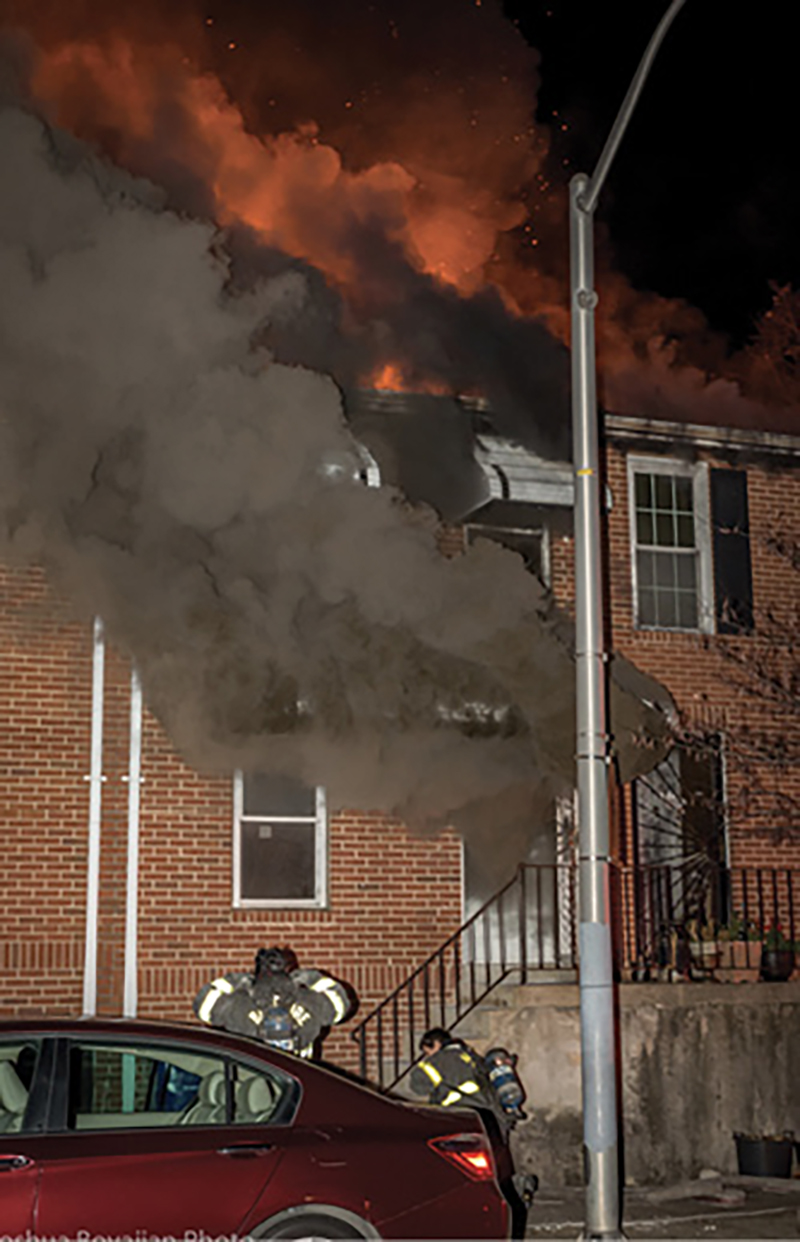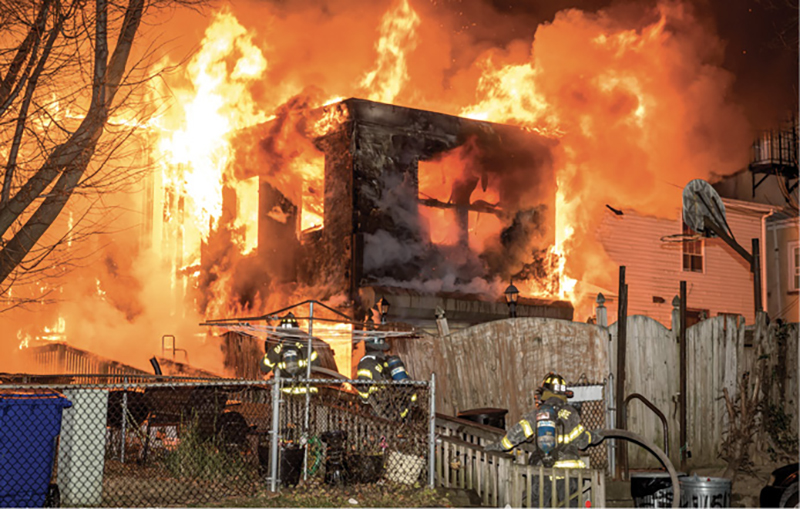FIRE FOCUS ❘ By Michael M. Dugan
December in Baltimore, Maryland, can be chilly, as it was when Baltimore Fire Department units were dispatched to a fire on West Lexington Street in a block of row homes. There was a light wind blowing, and the reported address of the fire was an area that is fully occupied. These types of buildings are in many cities and suburban areas of the country. On arrival, firefighters had heavy fire showing from the rear first and second floors and extending to exposures B and D.
- Firefighters and Construction: Row Frames
- FIREGROUND STRATEGIES: OLD- AND NEW-LAW MULTIPLE DWELLINGS
- Fires in Row Frames
The original fire building was occupied, but no one was home at the time of the fire. It also had a two-story rear addition that was semi-attached to the main home, so the responding units had exposure issues on three sides of the fire building with a fire that had a significant headway before their arrival. The initial fire was an interior fire, and when it finally showed and broke through, it started to run the soffits.
When dealing with a fire this advanced on arrival, it is always best to call for additional help as soon as possible. It is better to have the help and not need it than to be trying to play catch-up. Additional units will be needed in the exposures and on the roof to get ahead of the spreading fire.

(1) The fire has gained significant headway and is burning in the cockloft and spreading toward the exposure because of prevailing wind conditions. The porch light and Christmas decorations indicate that these buildings are occupied. (Photos by Josh Boyajian.)

(2) A firefighter is working on the door; you can see by the smoke conditions showing around the front door that the fire conditions are intense.

(3) A member has forced the front door and is searching the building for fire and occupants.

(4) The apparatus operator and roof firefighter are preparing the ladder to go to the roof. This will be an important way for the members to exit the roof if conditions deteriorate.
The firefighter on the roof is going to be one of the critical factors in a fire of this type. He is the eyes of the incident commander (IC), and their communications will set the tone for this fire. The amount of smoke vs. fire is incredibly important for the IC to know to get ahead of this fire. A hole over the main body of fire is a critical tactic to help prevent fire spread throughout the cockloft. Building knowledge gained on inspections and previous runs is also a factor to consider: Do these buildings have a common cockloft or attic space or are they protected by a firewall between buildings? This knowledge will drive certain operational tasks.
These buildings in Baltimore had a common cockloft, and the fire ended up getting into five buildings. As a firefighter operating on the roof of a fire building, always ensure that you have at least two ways off the roof—such as an aerial ladder placed three or four buildings down and your original way onto the roof. You might be cut off from your original escape route, so have at least one more and maybe two escape routes. Ladder company operators and officers should place apparatus ladders and maybe portables to the roof to ensure that members can get off if necessary.

(5) The rear setback addition is fully involved; personnel are going to need help in the rear. This information is vital to get to the IC for needed support.

(6) The fire in the original building has exposed at least two buildings on the B side so far, and the building on the D side has had the siding melted off. Resources are going to be needed in these units.

(7) The rear of the building needed a deck gun to knock down the amount of fire that involved the rear of the buildings. Getting the needed resources is critical.
The roof firefighter should cut the original hole over the fire as quickly as possible and pull the hole to relieve the cockloft of the pent-up fire and gases. The hole should be small enough to manage with the number of firefighters available on the roof. If you have only one or two people on the roof, then a smaller hole opened quickly is better that waiting for more help to make a larger hole. Remember that the hole will relieve conditions in the cockloft and limit fire spread, so quicker is better. You can always expand the hole if necessary.
After you make an initial hole over the fire, make an inspection hole on the exposure that is the most in danger or the most involved. This will allow you to communicate to the IC to direct resources as they arrive. These are inspection holes and should be small enough not to draw the fire to them. They can be a kerf cut (only a blade width) or a small triangle cut. Hopefully, help is arriving on the roof, and another unit or team can do the same on the opposite exposure.
Units sent into the exposures must bring a charged hoseline and at least one hook (two are preferable). As you get to the top floor, make only small holes until you determine the status of the cockloft space over your head. If the fire is already ahead of you, then skipping this building might be the best move to get ahead of the fire and push it back toward the original fire building. Once you are ahead of the spreading fire, pull the ceiling and flow water into the cockloft toward the building of origin.
Baltimore firefighters had a fire that had gained significant headway before their arrival; they accomplished extinguishment very quickly for the amount of fire present. This shows the importance of training and communication. The time we spend drilling on operations and communication will pay dividends on the fireground during operations.
Michael M. Dugan is a captain (ret.) and a 27-year veteran of the Fire Department of New York. He received the James Gordon Bennett medal in 1992 and the Harry M. Archer Medal in 1993. He is also a former volunteer firefighter in the Halesite (NY) Fire Department and the recipient of the FDIC International 2021 Lifetime Achievement Award.

